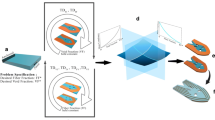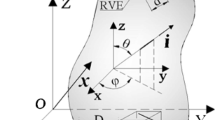Abstract
Fiber-reinforced composite materials have excellent specific stiffness, specific strength, and other properties, and have been increasingly widely used in the field of advanced structures. However, the design space dimensions of fiber-reinforced composite materials will expand explosively, bringing challenges to the efficient analysis and optimal design of structures. In this paper, the authors propose an explicit topology optimization method based on the moving morphable components for designing the fiber-reinforced material. We constrain the intersection area between components to guarantee the independence of each component and avoid the situation that one component is cut by other components. Adding the fiber orientation angle as a design variable, the method can optimize the structural layout and the fiber orientation angle concurrently under the given number of fiber layers and layer thickness. We use two classical examples to verify the feasibility and accuracy of the proposed method. The optimized results are in good agreement with the designs obtained by the 99-line code. The authors also popularize the proposed method to engineering structure. The results manifest that the proposed method has great value in engineering application.




Similar content being viewed by others
Change history
17 March 2022
A Correction to this paper has been published: https://doi.org/10.1007/s10338-022-00313-8
09 May 2022
A Correction to this paper has been published: https://doi.org/10.1007/s10338-022-00327-2
References
Sun Z, Cui RH, Cui TC, Liu C, Shi SS, Guo X. An optimization approach for stiffener layout of composite stiffened panels based on moving morphable components (MMCs). Acta Mech Solida Sin. 2020;33:1–13. https://doi.org/10.1007/s10338-020-00161-4.
da Silva ALF, Salas RA, Silva RA, Silva ECN, Reddy JN. Topology optimization of fibers orientation in hyperelastic composite material. Compos Struct. 2020;231:111488. https://doi.org/10.1016/j.compstruct.2019.111488.
Tsai SW, Sihn S, Melo JDD. Trace-based stiffness for a universal design of carbon-fiber reinforced composite structures. Compos Sci Technol. 2015;118:23–30. https://doi.org/10.1016/j.compscitech.2015.08.003.
Awad ZK, Aravinthan T, Yan ZG, Gonzalez F. A review of optimization techniques used in the design of fibre composite structures for civil engineering applications. Mater Des. 2012;33:534–44. https://doi.org/10.1016/j.matdes.2011.04.061.
Kong L, Zuo XB, Zhu SP, Li ZP, Shi JJ, Li L, Feng ZH, Zhang DH, Deng DY, Yu JJ. Novel carbon-poly(silacetylene) composites as advanced thermal protection material in aerospace applications. Compos Sci Technol. 2018;162:163–9. https://doi.org/10.1016/j.compscitech.2018.04.038.
Wadbro E, Berggren M. Topology optimization of an acoustic horn. Comput Meth Appl Mech Eng. 2006;196:420–36. https://doi.org/10.1016/j.cma.2006.05.005.
Smith H, Norato JA. Topology optimization with discrete geometric components made of composite materials. Comput Meth Appl Mech Eng. 2021;376. https://doi.org/10.1016/j.cma.2020.113582.
Zhang WS, Yuan J, Zhang J, Guo X. A new topology optimization approach based on Moving Morphable Components (MMC) and the ersatz material model. Struct Multidiscip Optim. 2016;53:1243–60. https://doi.org/10.1007/s00158-015-1372-3.
Guo X, Cheng GD. Recent development in structural design and optimization. Acta Mech Sin. 2010;26:807–23. https://doi.org/10.1007/s10409-010-0395-7.
Bendsoe MP, Kikuchi N. Generating optimal topologies in structural design using a homogenization method. Comput Meth Appl Mech Eng. 1988;71:197–224. https://doi.org/10.1016/0045-7825(88)90086-2.
Bendsoe MP. Optimal shape design as a material distribution problem. Struct Optim. 1989;1:193–202.
Zhou M, Rozvany G. The COC algorithm, part II: topological, geometry and generalized shape optimization. Comput Meth Appl Mech Eng. 1991;89(89):309–36.
Wang MY, Wang XM, Guo DM. A level set method for structural topology optimization. Comput Meth Appl Mech Eng. 2003;192:227–46. https://doi.org/10.1016/S0045-7825(02)00559-5.
Allair G, Jouve F, Toader AM. Structural optimization using sensitivity analysis and a level-set method. J Comput Phys. 2004;194:363–93. https://doi.org/10.1016/j.jcp.2003.09.032.
Xie YM, Steven GP. A simple evolutionary procedure for structural optimization. Comput Struct. 1993;49:885–96. https://doi.org/10.1016/0045-7949(93)90035-C.
Guo X, Zhang WS, Zhong W. Stress-related topology optimization of continuum structures involving multi-phase materials. Comput Meth Appl Mech Eng. 2014;268:632–55. https://doi.org/10.1016/j.cma.2013.10.003.
Zhuang CA, Xiong ZH, Ding H. Topology optimization of multi-material for the heat conduction problem based on the level set method. Eng Optimiz 2010;42:811–31. https://doi.org/10.1080/03052150903443780.
Grejtak T, Jia X, Feppon F, Joynson SG, et al. Topology Optimization of Composite Materials for Wear: A Route to Multifunctional Materials for Sliding Interfaces. Adv Eng Mater. 2019;21:1900366. https://doi.org/10.1002/adem.201900366.
Ghasemi H, Park HS, Rabczuk T. A multi-material level set-based topology optimization of flexoelectric composites. Comput Meth Appl Mech Eng. 2018;332:47–62. https://doi.org/10.1016/j.cma.2017.12.005.
Luo QT, Tong LY. A deformation mechanism based material model for topology optimization of laminated composite plates and shells. Compos Struct. 2017;159:246–56. https://doi.org/10.1016/j.compstruct.2016.09.056.
Zhang H, Ding XH, Wang Q, Ni WY, Li H. Topology optimization of composite material with high broadband damping. Comput Struct. 2020;239:106331. https://doi.org/10.1016/j.compstruc.2020.106331.
Giraldo-Londoño O, Mirabella L, Dalloro L, Paulino GH. Multi-material thermomechanical topology optimization with applications to additive manufacturing: design of main composite part and its support structure. Comput Meth Appl Mech Eng. 2020;363:112812. https://doi.org/10.1016/j.cma.2019.112812.
Stegmann J, Lund E. Discrete material optimization of general composite shell structures. Int J Numer Methods Eng. 2005;62:2009–27. https://doi.org/10.1002/nme.1259.
Bruyneel M. SFP—a new parameterization based on shape functions for optimal material selection: application to conventional composite plies. Struct Multidiscip Optim. 2011;43:17–27. https://doi.org/10.1007/s00158-010-0548-0.
Setoodeh S, Abdalla MM, Gurdal Z. Combined topology and fiber path design of composite layers using cellular automata. Struct Multidiscip Optim. 2005;30:413–21. https://doi.org/10.1007/s00158-005-0528-y.
Sun Z, Li D, Zhang WS, et al. Topological optimization of biomimetic sandwich structures with hybrid core and CFRP face sheets. Compos Sci Technol. 2017;142:79–90. https://doi.org/10.1016/j.compscitech.2017.01.029.
Gao T, Zhang WHH, Duysinx P. Simultaneous design of structural layout and discrete fiber orientation using bi-value coding parameterization and volume constraint. Struct Multidiscip Optim. 2013;48:1075–88. https://doi.org/10.1007/s00158-013-0948-z.
Nomura T, Dede EM, Lee J, et al. General topology optimization method with continuous and discrete orientation design using isoparametric projection. Int J Numer Methods Eng. 2015;101:571–605. https://doi.org/10.1002/nme.4799.
Yan J, Duan ZY, Lund E, Wang JY. Concurrent multi-scale design optimization of composite frames with manufacturing constraints. Struct Multidiscip Optim. 2017;56:519–33. https://doi.org/10.1007/s00158-017-1750-0.
Yan J, Duan ZY, Lund E, Zhao GZ. Concurrent multi-scale design optimization of composite frame structures using the Heaviside penalization of discrete material model. Acta Mech Sin. 2016;32:430–41.
Jiang D, Hoglund R, Smith DE. Continuous fiber angle topology optimization for polymer composite deposition additive manufacturing applications. Fibers. 2019;7:14. https://doi.org/10.3390/fib7020014.
Guo X, Zhang WS, Zhong WL. Doing topology optimization explicitly and geometrically—a new moving morphable components based framework. J Appl Mech-Trans ASME. 2014;81:081009. https://doi.org/10.1115/1.4027609.
Hoang VN, Nguyen HB, Nguyen-Xuan H. Explicit topology optimization of nearly incompressible materials using polytopal composite elements. Adv Eng Softw. 2020;149:102903. https://doi.org/10.1016/j.advengsoft.2020.102903.
Shi SS, Sun Z, Ren MF, Chen HR, Hu XZ. Buckling resistance of grid-stiffened carbon-fiber thin-shell structures. Compos Pt B-Eng. 2013;45:888–96.
Zhang WS, Song JF, Zhou JH, et al. Topology optimization with multiple materials via moving morphable component (MMC) method. Int J Numer Methods Eng. 2018;113(11):1653–75.
Sigmund O. A 99 line topology optimization code written in Matlab. Struct Multidiscip Optim. 2001;21:120–7. https://doi.org/10.1007/s001580050176.
Acknowledgements
We would like to acknowledge the financial supports from the National Key Research and Development Plan (2020YFB1709401), the National Natural Science Foundation of China (11872138, 11702048), Dalian Young TechStar Project (2019RQ045, 2019RQ069), and the Scientific Research Fund Project of Education Department of Liaoning Province (JDL2020021).
Author information
Authors and Affiliations
Corresponding author
Ethics declarations
Conflict of interests
The authors declare that they have no competing interests.
Additional information
The original online version of this article was revised: During production of the article unfortunately several typesetting mistakes have been introduced.
The original online version of this article was revised: During the production of this article, one of the original authors Xu Guo proposed to remove his name from the author list due to too many mis-typed symbols in the on-line version of this manuscript provided by the text-processing corporation.
Rights and permissions
About this article
Cite this article
Sun, Z., Song, Z., Song, J. et al. Structural Optimization of Fiber-Reinforced Material Based on Moving Morphable Components (MMCs). Acta Mech. Solida Sin. 35, 632–646 (2022). https://doi.org/10.1007/s10338-021-00305-0
Received:
Revised:
Accepted:
Published:
Issue Date:
DOI: https://doi.org/10.1007/s10338-021-00305-0




